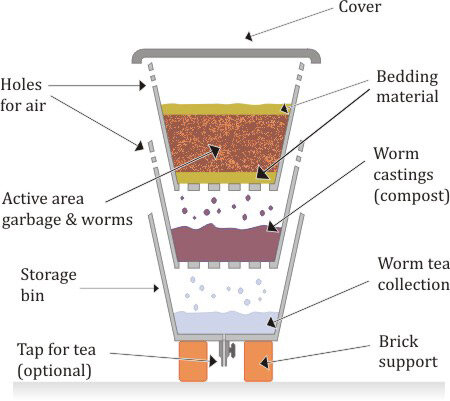It’s a Worm’s World: Composting in an Apartment or Small Space
LisaInGlasses / Getty Images
By: Emily Cremeans, Intern
“Information is like compost; it does no good unless you spread it around” -Eliot Coleman
It doesn’t take acres of land to create your own compost! Composting is the idea of taking organic ‘leftovers’ such as coffee grounds, dried egg shells, or cut up fruit and veggie scraps and utilizing them to reuse as nutrient filled fertilizer for your house plants, garden, or other areas with vegetation. In the United States about 28% of our waste is food scraps and yard waste that could be composted (EPA). I’m going to discuss an easy way to compost in a small space by using worms! But first, let’s talk about the benefits of composting.
Benefits of Composting
Composting comes with numerous benefits. One of the best benefits of composting is enriching your plants’ soil. The final product of compost is all natural and removes the need for unnecessary chemicals that can reduce the color and nutrient content of produce. The enriched soil retains water better and can help plants remain disease free. Compost also aids in production of beneficial fungi and bacteria that help plants absorb needed nutrients. Food waste produces high levels of methane, a dangerous greenhouse gas. Methane is more harmful than carbon dioxide because it traps more heat in the atmosphere. By composting, you are reducing the amount of emitted methane, lowering your carbon footprint and reducing heat trapped in the atmosphere.
http://illinoiscomposts.org/why-compost/
As a college student eager to develop more eco-friendly habits, learning to compost in my apartment was so exciting! Despite not having much outdoor space, it can be done. Through some simple research and low-cost materials, here is how your compost can be accomplished in an apartment or dorm.
How to Compost
All composting requires three ingredients: browns, greens, and waters. Browns include dead leaves, twigs, branches, or other fallen pieces of plants. Greens include things such as fruit and vegetable waste, grass, or even coffee grounds. Water provides moisture for your compost, where greens and browns provide carbon and nitrogen.
Composting can be done in your backyard or your kitchen. One of the easiest and most accessible ways of composting in a small area or indoors is through vermicomposting. Vermicomposting utilizes worms, specifically red worms because they are surface feeders, to transform organic waste into fertilizer that is nutrient rich for plants. Your compost fertilizer is superior to chemical fertilizers because chemical fertilizers deteriorate the color and nutrient content of produce much quicker. There are many different ways to create a container for vermicomposting. Check out the diagram below for one way that utilizes three bins. You can also buy ready to use systems online. In general, one pound of worms is ideal for every square foot of compost, about two pounds should be the maximum in a standard five gallon bucket or bin.
http://working-worms.com
The worms will need steady air flow, ventilation, and draining, therefore, holes need to be drilled on the top and bottom of the bin. Drainage at the bottom allows for the leachate to not collect at the bottom and create too much moisture. Light bedding is also needed to help with moisture collection. This can be newspaper clippings, dried leaves, and other materials of that sort. At the bottom there needs to be a thick layer of dry bedding, but not too compacted so there is still air flow, we can’t suffocate our worms. Once your bin is full of material, you’re ready to provide your worms with scraps of fruits, veggies, and grains. Try to avoid too much acidic waste and add dried egg or nut shells. Be careful to avoid overfeeding and make sure your scraps are not too big. Other than creating your own ‘free’ fertilizer, composting provides you and your plants to have the opportunity to be healthy, happy, and friendly to our wonderful planet.
Now that you know that composting can be done in a small space, I hope you’ll give it a try!
Sources Online to Get You Started
https://www.youtube.com/watch?v=mDIVpJgjoXQ
https://www.youtube.com/watch?v=LPsXy9gO40Y
Sources
“Composting at Home.” EPA, Environmental Protection Agency, 13 Nov. 2019, www.epa.gov/recycle/composting-home.
Cowan, Shannon. “How to Compost in an Apartment.” Eartheasy Guides & Articles, 8 Mar. 2018, learn.eartheasy.com/articles/how-to-compost-in-an-apartment/.
Fernandez, Kat. “How To Compost in Your Apartment or Dorm .” Spoon University, 26 June 2017, spoonuniversity.com/how-to/how-to-compost-in-your-apartment-or-dorm#:~:text=A bucket works well if, place it in another bin.



